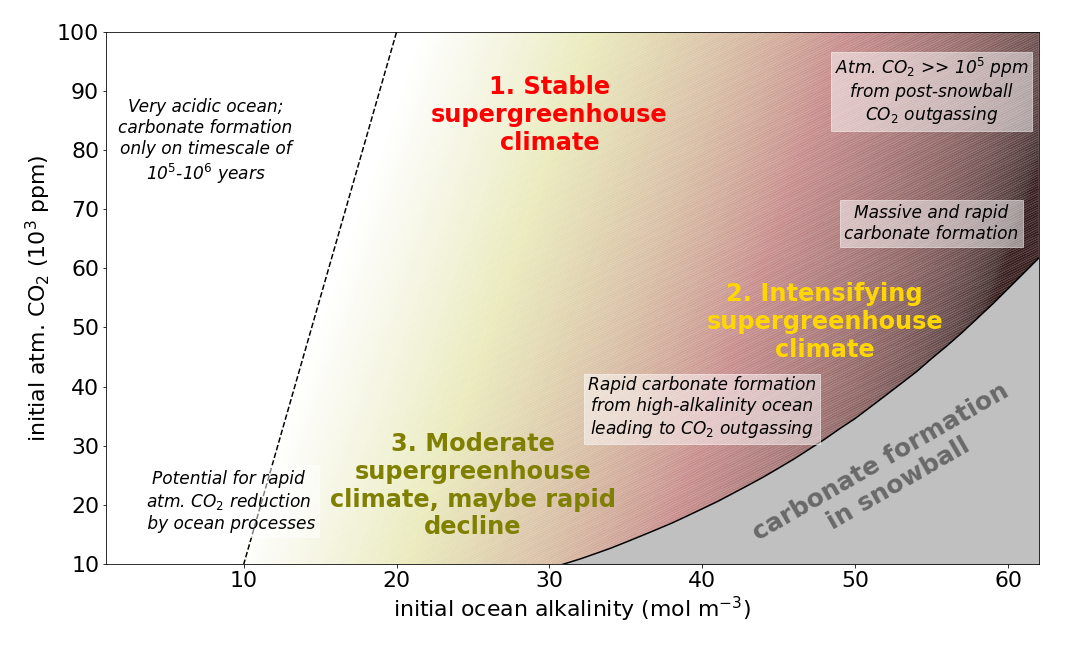What happens after a snowball Earth melts?
Deep in its geological past, the Earth underwent several periods of global glaciation. The two most well-known of those periods are the Sturtian and the Marinoan snowball Earth, which occurred between 720 and 635 million years ago and each lasted for millions of years. During a snowball Earth, CO2 accumulates in the atmosphere through continued and unbalanced volcanic outgassing, until eventually the greenhouse effect becomes so strong that the ice starts to melt in the tropics, initiating a cataclysmic transition into a much warmer climate. While the initiation of a snowball Earth and the processes leading to its deglaciation are studied relatively well, the snowball Earth aftermath has never been investigated using a coupled Earth system model. In their new publication, the three authors extend on a previous publication focusing on ocean dynamics (Ramme and Marotzke, 2022), now including the ocean biogeochemistry model HAMOCC and an interactive carbon cycle. This allows for the first time to study the dynamic interplay between climate, ocean circulation and the carbon cycle after a snowball Earth.

The MPI-M authors find that the ocean drives the evolution of the climate after a snowball Earth via five different mechanisms, which have not been considered in the previous literature. These mechanisms are the massive inflow of meltwater during the deglaciation, the removal of a potential initial disequilibrium between the atmosphere and ocean carbon reservoirs, the reappearance of biological activity, the general warming of the ocean and finally the inorganic formation of carbonate rocks from an alkaline ocean. However, which of these processes is dominating and how the supergreenhouse climate evolves depends on the uncertain chemical conditions at the start of the deglaciation (Fig. 1). In particular, the supergreenhouse climate was not necessarily a stable and hot climate over hundreds of thousands of years. It is also possible that the temperatures in the supergreenhouse climate were moderate and maybe even declined rapidly, that is, on a time scale of just a few thousand years.
The new study, which also represents the first scientific application of ICON in its fully coupled Earth system model setup (ICON-ESM, Jungclaus et al., 2022), provides new insight into the climatic conditions after the Marinoan snowball Earth 635 million years ago. During this time, important milestones in the evolution of the Earth system were reached, like the first widespread appearance of multicellular life on Earth and the oxygenation of the atmosphere to modern-like levels. Previously, the extreme temperatures in the supergreenhouse climate have been considered to be a threat to the early forms of life existing during that time, but the severeness of these temperatures is now questioned by the new study. Future work might combine geological data with the findings of this study to better constrain the climatic conditions during that time and how they might have affected the evolution of life and the Earth system.
Original publication
Ramme, L., Ilyina, T. & Marotzke, J. Moderate greenhouse climate and rapid carbonate formation after Marinoan snowball Earth. Nat Commun 15, 3571 (2024). https://doi.org/10.1038/s41467-024-47873-6
Contact
Dr. Lennart Ramme
Max Planck Institute for Meteorology
lennart.ramme@mpimet.mpg.de
Prof. Dr. Jochem Marotzke
Max Planck Institute for Meteorology
jochem.marotzke@mpimet.mpg.de
Prof. Dr. Tatiana Ilyina
Universität Hamburg / Max Planck Institute for Meteorology
tatiana.ilyina@uni-hamburg.de
